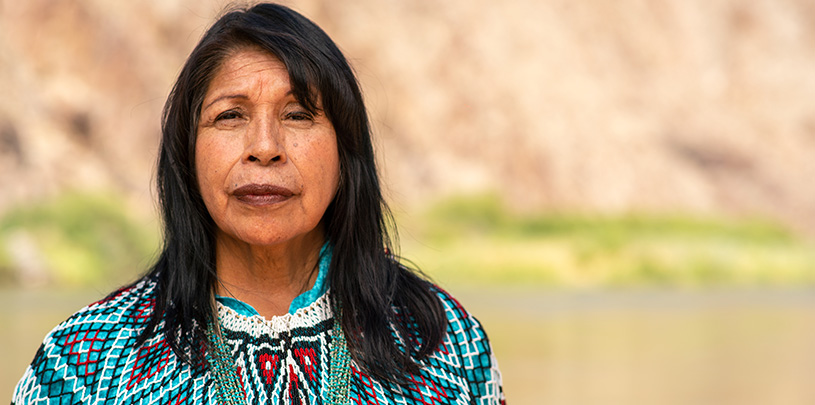
 by Sarana Riggs, Grand Canyon Manager
by Sarana Riggs, Grand Canyon Manager
Growing up on the Hualapai reservation, Loretta Jackson-Kelly was the youngest of nine children — the last one on the totem pole when it came to making the 20-mile trip down Diamond Creek Road into the heart of the Grand Canyon. Visiting the Colorado River was a treat for her older brothers and sisters, but Jackson-Kelly wasn’t allowed to go because she was too young. As she waited for her chance, she soaked up cultural teachings about the Grand Canyon — she was taught that the canyon was and is a sacred place, and that to visit and coexist, she must say prayers.
Jackson-Kelly went on to work for the Hualapai Tribe’s Department of Cultural Resources for 25 years, in addition to the Grand Canyon Resort Corporation, which runs helicopter and boat tours and operates the well-known glass bridge called the Skywalk. Here, we talk with Jackson-Kelly about her Hualapai ties to the Grand Canyon, stereotypes, and respectful visitation of her ancestral lands.
I am a Hualapai tribal member with the Hualapai tribe. My Hualapai name is Ha’Ka’Ama Baqui, which means “river woman.” I am from the band of Hel: Ba’Ja (Milkweed Springs) and Ha”Ka’ Sa’ (Sulfur Hot Springs), and I’ve lived here on the Hualapai Indian reservation most of my entire life. I’ve been on river trips with the Grand Canyon Park Service since the early 1990s, and that was mainly to familiarize myself with the cultural sites, archaeology sites, and traditional cultural places of and for the Hualapai people. There are numerous areas we consider very sacred, which I will not divulge, but in general the creeks, and the seeps, and the springs, and the Little Colorado River confluence area. We regard those as very sacred areas.
Our ancestral homelands, as far as the Hualapai people go, encompassed 7 million acres of northwestern Arizona. And this is before the coming of the Anglos, and we traversed from area to area utilizing the natural resources for food, for medicine, for housing, for trade. And within the 7 million acres there were 13-14 bands of Hualapai people, or Pai, or Ba’Ja’, which means “the people.” Each band was named after a unique resource within their territory.
Since time immemorial, the Colorado River and the Grand Canyon have been a very important link to our existence, to the time of our creation. Our ancestors had always told us not to forget that the middle of the river is the backbone of the people, and without that backbone, we cannot survive. And given that, we always paid homage and respect to the river, because the river is a healing body of water. And when you say your prayers, and you wash yourself with the water source, you’re giving yourself very many blessings as well as letting go of all the negativity that might be building up around. And you pray for your people. We believe that the fish of the Colorado River are our ancestors. And that, meaning native fish. We’re not talking about introduced species, but that the native fish were our ancestors, which can tell you our connection to all the living beings around here.
In the two worlds that I worked in, one for the tribe and one for the economic side of it at Grand Canyon Resort Corporation, we have a lot of foreigners that come and expect certain things from the Native Americans. And usually they are stereotypical, like: do we still live in teepees, do we have running water, do we have houses that we live in, do we have plumbing.
But we are here, we do exist, we’re modern, and we live the modern life. Just like everybody else. So I think that just in educating the public and letting them know you are a distinct group of people, especially if you retain your language, you retain the practices of the culture that are not of the mainstream but a unique group with land that are considered sovereign lands.
When you are here, on Hualapai lands, there’s a lot of respect that you have to show to be appreciative of being out in the open, listening to the river, listening to what’s speaking from the rocks, from the plants. And just to show respect to the Hualapai people as you’re visiting is really important. I think what we all need to do is to pause a little, and take in what we can here in this type of setting. This is our world. This is everybody’s world. And we all have to help each other in taking care of the world.
Placing Native voices at the forefront of education, stewardship, and economic opportunities in Grand Canyon National Park.
Read MoreNative voices set the tone for the next era of Grand Canyon National Park in this collection of stories about cultural identities, histories, and ties to the Grand Canyon.
Read MoreAs Grand Canyon National Park turns 100, Native knowledge and culture needs to be more involved in the next 100 years of park management.
Read More